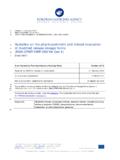Transcription of Guideline on the pharmacokinetic and clinical …
1 30 Churchill Place Canary Wharf London E14 5EU United Kingdom An agency of the European Union Telephone +44 (0)20 3660 6000 Facsimile +44 (0)20 3660 5555 Send a question via our website European Medicines Agency, 2014. Reproduction is authorised provided the source is acknowledged. 20 November 2014 EMA/CHMP/EWP/280/96 Committee for Medicinal Products for Human Use (CHMP) Guideline on the pharmacokinetic and clinical evaluation of modified release dosage forms (EMA/CPMP/EWP/280/96 Corr1) Draft Agreed by Pharmacokinetics Working Party October 2012 Adoption by CHMP for release for consultation 21 February 2013 End of consultation (deadline for comments)
2 15 September 2013 Agreed by Working Party 23 October 2014 Adoption by Committee 20 November 2014 Date for coming into effect 1 June 2015 This Guideline replaces Guideline on Modified Release Oral and Transdermal Dosage Forms Section II ( pharmacokinetic and clinical Evaluation (EMA/CPMP/EWP/280/96 Corr1) Keywords Modified release, prolonged release, delayed release, transdermal drug delivery systems (TDDS), bioequivalence, pharmacokinetics, biowaiver, in vitro dissolution, generics, oral, intramuscular and subcutaneous Guideline on the pharmacokinetic and clinical evaluation of modified release dosage forms (EMA/CPMP/EWP/280/96 Corr1) EMA/CHMP/EWP/280/96 Page 2/46 Table of contents Executive summary.)
3 4 1. Introduction (background) .. 4 Types of Modified release and dosage forms .. 4 Rationale for Development .. 5 The clinical rationale .. 5 Considerations for use and posology .. 6 2. 6 3. Legal basis and relevant guidelines .. 6 4. Applications for modified release dosage forms of new chemical entities 7 pharmacokinetic studies required for oral MR formulation of a new chemical entity .. 7 Food effect studies with oral modified release forms .. 8 pharmacokinetic Studies required for Transdermal Drug Delivery Systems (TDDS) of a new chemical entity .. 8 pharmacokinetic Studies required for intramuscular/subcutaneous Depot formulations of a new chemical entity.
4 9 5. Application for a modified release formulation of a drug that is authorised in a formulation with a different release rate .. 9 pharmacokinetic studies .. 10 Rate and extent of absorption, fluctuation .. 11 Variability .. 11 Dose 12 Factors affecting the performance of a modified drug formulation .. 12 Other points to consider .. 14 Therapeutic studies .. 15 Waiving of therapeutic studies .. 15 How to design clinical studies .. 16 6. Abridged application for modified release forms referring to a marketed modified release form .. 17 Prolonged release formulations for oral administration .. 18 Studies generally required to demonstrate bioequivalence.
5 18 Strength(s) to be evaluated .. 20 Delayed release formulations .. 21 Studies generally required to demonstrate bioequivalence: .. 21 Strength(s) to be evaluated .. 21 Prolonged residence time in the stomach .. 22 Multiphasic modified release products .. 22 Studies generally required to demonstrate bioequivalence: .. 22 Intramuscular/Subcutaneous Depot Formulations .. 22 Studies generally required to demonstrate bioequivalence: .. 22 Strength to be evaluated .. 23 Guideline on the pharmacokinetic and clinical evaluation of modified release dosage forms (EMA/CPMP/EWP/280/96 Corr1) EMA/CHMP/EWP/280/96 Page 3/46 Transdermal Drug Delivery Systems (TDDS).
6 23 Studies generally required to demonstrate bioequivalence: .. 23 Strength to be evaluated .. 24 6. 6. Bracketing approach .. 24 New strength for an already approved MR product .. 24 Evaluation .. 25 Parameters to be 25 Evaluation characteristics and acceptance criteria .. 25 Effects of alcohol .. 27 Further points to consider for bioequivalence studies .. 28 Definitions .. 28 Appendix I: sensitisation and irritation test for transdermal products .. 30 Appendix II: in vivo skin adhesion .. 34 Appendix III: in vitro in vivo correlation .. 36 Appendix IV: summary of study recommendations for abridged applications.
7 43 Guideline on the pharmacokinetic and clinical evaluation of modified release dosage forms (EMA/CPMP/EWP/280/96 Corr1) EMA/CHMP/EWP/280/96 Page 4/46 Executive summary The primary purpose of this Guideline is to define the studies necessary to investigate the efficacy, safety, biopharmaceutic and pharmacokinetic properties of modified release formulations following oral, intramuscular and subcutaneous administration and transdermal dosage forms in man and to set out general principles for designing, conducting and evaluating such studies. The revision of the Note for Guidance on the Investigation of Bioavailability and Bioequivalence (EWP/QWP/1401/98) generated the necessity of consequential adjustments.
8 Furthermore the Guideline provides updated requirements for transdermal drug delivery systems (TDDS) and addresses recommendations for specific modified release formulations, for intramuscular/subcutaneous depot formulations. 1. Introduction (background) Types of Modified release and dosage forms Modified release dosage forms are formulations where the rate and/or site of release of the active ingredient(s) are different from that of the immediate release dosage form administered by the same route. This deliberate modification is achieved by special formulation design and/or manufacturing methods. Modified release dosage forms covered by this Guideline include orally, intramuscularly, subcutaneously administered modified release and transdermal dosage forms.
9 Prolonged release dosage forms: Prolonged release dosage forms are modified release dosage forms showing a sustained release compared to that of an immediate release dosage form administered by the same route. Delayed release dosage form: The release of the active substance from such modified release dosage forms is delayed for a certain period after administration or application of the dosage. The subsequent release is similar to that of an immediate release dosage form. Multiphasic release dosage forms: o Biphasic Release: The first phase of drug release is determined by a fast release dose fraction providing a therapeutic drug level shortly after administration.
10 The second extended release phase provides the dose fraction required to maintain an effective therapeutic level for a prolonged period. o Pulsatile Release: Pulsatile drug release is intended to deliver a burst of drug release at specific time intervals. Multiple-unit: A multiple unit dosage form contains a plurality of units pellets or beads each containing release controlling excipients, in a gelatine capsule or compressed in a tablet Single-unit: The single-unit dosage forms consist of only one unit, osmotic tablet. Intramuscular/subcutaneous depot formulations: A depot injection is usually a subcutaneous or intramuscular product which releases its active compound continuously over a certain period of time.












